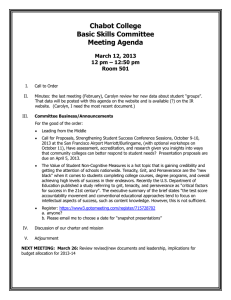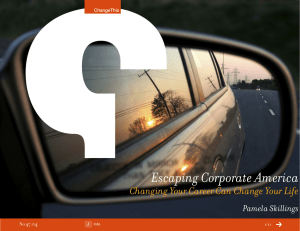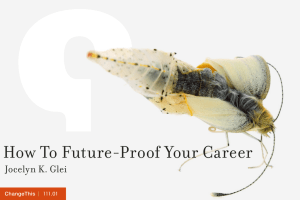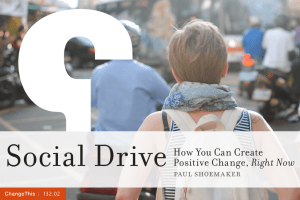Why Grit is The New Black |
advertisement
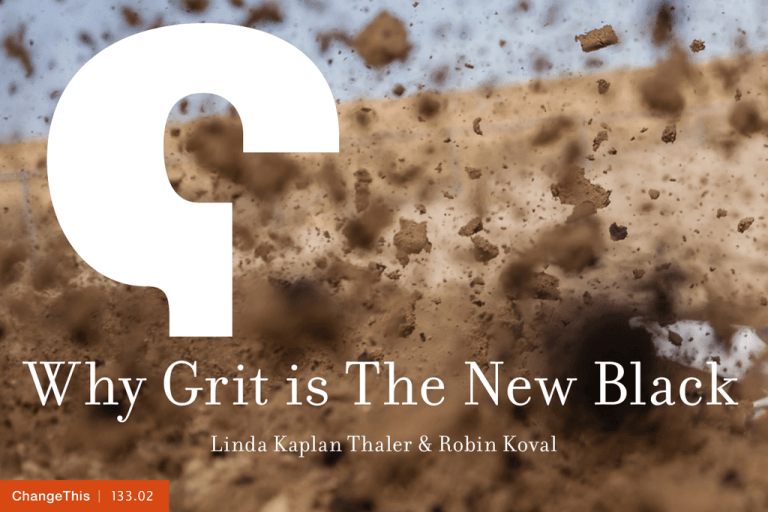
Why Grit is The New Black Linda Kaplan Thaler & Robin Koval ChangeThis | 133.02 Can you guess what General Colin Powell, Michael Jordan, and Steven Spielberg have in common, other than their extraordinary success in life? Each of them was completely ordinary growing up. Colin Powell was a C student in college, Michael Jordan didn’t even qualify for his high school varsity basketball team (yes, you read that correctly), and Steven Spielberg got rejected three times from film school (the same film school, USC, that now has Spielberg symposiums to study his blockbuster movies). None of these luminaries possessed the coveted “it” factor. They were not born with Mensa IQs or virtuoso talents. In fact, no one would have predicted their future rise to glory. What they did possess was the “grit” factor—guts, resilience, initiative, and tenacity. In fact, of so-called born prodigies, only 2% ever achieve anything remotely resembling success. Yet, 98% of mega successful people possess grit. ChangeThis | 133.02 Emerging research proves, beyond a doubt, that grit is the most accurate predictor of success in achieving life goals. Yet grit is often seen as a rather antiquated 19th century ideal, more akin to methodical stick-to-itiveness and survival than the secret sauce to success. But, the truth is, grit is about sweat, not swagger, character, not charisma. Grit is the result of a hard-fought struggle, a willingness to take risks, a passionate pursuit of one’s goals, and the perseverance to continue against all odds. And the best part of grit is that anyone can develop and nurture it, whether you’re eight or eighty-eight. Even Pablo Casals, one of the world’s most acclaimed cellists, when asked why at age 93 he still practiced several hours a day, thoughtfully replied, “I’m beginning to notice some improvement.” “ Grit is about sweat, not swagger, character, not charisma. Grit is the result of a hard-fought struggle, a willingness to take risks, a passionate pursuit of one’s goals, and the perseverance to continue against all odds. ChangeThis | 133.02 Unfortunately, we live in an A.D.D. culture that is often at odds with strengthening our focus and tenacity. The dizzying bombardment of data, social media, and information makes staying on goal harder than ever. We expect answers in a nanosecond Google search and are accosted with YouTube sensations that, seemingly, have glided from obscurity to unbridled stardom in a matter of days. We want what we want, and we want it now. In the early 1970s, Stanford University psychologist Walter Mischel conducted the well-known “Marshmallow Experiment,” which sought to predict the lifelong effects of one’s ability to delay gratification, a key component to grit. In this study, a researcher would offer a young child a tempting marshmallow. The child was then told that the researcher had to leave the room for a few minutes and, if they waited to eat the gooey treat until he came back, he or she would be rewarded with two marshmallows to munch on. In follow up studies several years later, the study revealed that those children who were able to wait longer for their reward tended to have better life outcomes as measured by academic and professional success. Although a well acclaimed study, if you would have gobbled down the marshmallow at first sight (we, sadly, would probably have inhaled it in seconds), all is not lost. Because delayed gratification, perseverance, tenacity, and resilience can all be taught. ChangeThis | 133.02 And here are some of the lessons we have learned from ground breaking new research, as well as interviews with some of the grittiest, and most successful people on the planet: 1. Don’t Flatter Yourself Since the late 1960s, two generations of children were raised under the banner of the self-esteem movement, brought to popularity by the psychologist Nathaniel Brandon (“The Psychology of Self-Esteem”). Parents and educators were told that praise would give their children more confidence, which, in turn, would help them become more successful. The result? Every child got a trophy, even if it was for a 7th place soccer match, and grade inflation became the academic model du jour across the nation. The fact that so many of us think we are gifted and exceptional has thoroughly permeated pop culture. In the movie The Incredibles, the main character says, “They keep inventing new ways to celebrate mediocrity.” Unfortunately, aside from becoming a laughable punch line, the whole self-esteem movement was a complete disaster. The initiative failed to improve grades or reduce anti-social behavior, and deterred many children from putting in that extra effort, undermining the natural grit that this nation was built on. Luckily, the pendulum is starting to swing back in the right direction. ChangeThis | 133.02 As English teacher David McCullough Jr. told the 2012 graduating class Wellesley High School: “Contrary to what your U9 soccer trophy suggests… and your glowing seventh-grade report card… you’re nothing special.” We couldn’t agree more. Developing your grit means you don’t expect or need inflated praise or a high IQ score in order to succeed. You start from a place of “I’m not extraordinary,” and work your way up to an extraordinary life. 2. Ditch the Dream In our dreams, we always get to be the award-winning director, the Pulitzer Prize recipient, or the New York Times bestselling author. No wonder, when the alarm clock sounds, most of us hit the snooze button—we want to linger in dreamland just a little longer. So much is going on there.Except, of course, life. There’s an old Yiddish proverb that, loosely translated, goes something like this: If you want your dreams to become a reality, wake up already! Too often, the whole gauzy adage of “following your dream” has taken the place of more attainable aspirations: setting your sights on a goal, formulating a plan, charting a path, and steadily working forward from milepost to milepost. ChangeThis | 133.02 And while the dreamers are still in la-la land, the doers are taking victory laps, because they had the good sense to be in the real, day to day now, and get to work. So the next time you find yourself daydreaming about the glory to come, give yourself a mental kick in the head, and get back to the mundane tasks ahead. Each problem solved will move you higher up the mountain, even if it feels like you are climbing Mount Everest with a toothpick. “ Too often, the whole gauzy adage of “ following your dream” has taken the place of more attainable aspirations: setting your sights on a goal, formulating a plan, charting a path, and steadily working forward from milepost to milepost. ChangeThis | 133.02 3. Lose the Safety Net No matter where you are headed, attempting something new is often filled with fear and trepidation. But, as Albert Einstein once said, “A ship is always safe on the shore—but that is not what is was built for.” And no one knows what it feels like to embrace fear better than high wire artist Nik Wallenda, who recently walked across the Grand Canyon without a safety net. “Fear is negative,” he told us, “you can either be overtaken by it, or you can overcome it.” We believe this is a mantra for anyone seeking to excel, no matter what his or her passionate pursuit in life. Fear is your gut telling you that you need to identify the problem at hand, over prepare for anything that could possibly derail you, and putting in the sweat equity needed to perfect the task, whether it’s tomorrow’s PowerPoint presentation or applying for that long awaited promotion. Then, when confidence becomes muscle memory, panic is replaced by peak performance. ChangeThis | 133.02 4. Embrace Boredom Once you’ve decided to take that leap, there’s a long road ahead between effort and achievement. And that path is littered with years of practice, difficult training and a whole lot of monotonous chores. This is where most career paths hit a dead end. We’re not good at playing the waiting game. Unlike our very patient ancestors, who spent eons rubbing two sticks together, without the benefit of Candy Crush to help pass the time, we hate to wait. For anything. It’s no wonder that burgeoning research has revealed that, in order to succeed, we’re going to have to get a lot more comfortable with taking on tedious tasks, and more often than not, being bored while doing them. In fact, it’s the reason that Pala Olafsdottir, a renowned Icelandic educator, now teaches kindergarteners how to embrace boredom, with activities such as knitting or just sitting still doing nothing. These soft skills teach self-discipline and self-control to children in their formative years, and many now believe these traits will help ensure their future success. Boredom has some unexpected upsides as well. While executing mindless tasks our brains, which are hard-wired to solve problems, leave the neurons free to wander a bit, often leading ChangeThis | 133.02 to new creative ideas and innovative solutions to old ones. So the next time you rush to fill the void checking for texts and emails, check out your navel for a while. You just might be surprised at what a little navel gazing can lead to. “ In order to succeed, we’re going to have to get a lot more comfortable with taking on tedious tasks, and more often than not, being bored while doing them. 5. Make Your Bed US Navy admiral William H. McRaven is a former Navy SEAL who believes one of the most important lessons he learned as a cadet was how to make his bed, expertly and flawlessly. Although this mundane chore seemed ridiculous at the time, especially in light of the grueling and punishing training of Navy SEALS, McRaven said the wisdom of this task revealed itself in the months, and years ahead: ChangeThis | 133.02 “If you make your bed every morning, you will have accomplished the first task of the day. It will give you a small sense of pride, and it will encourage you to do another task, and another and another. … Making your bed will also reinforce the fact that little things in life matter. [Because] if you can’t do the little things right, you will never do the big things right.” We couldn’t agree more. As silly as it sounds, the feel-good moment of accomplishing something before you walk out the door can give your still sleepy endorphins just the boost you need to work a little harder that day. 6. Bend Like Bamboo The novelist Alice Walker said that “nature has a funny way of breaking what does not bend.” Success does not come from a “my way or the highway” attitude, but from one’s ability to adapt, change direction, and in the process, be open to a sky full of opportunities. So we looked for inspiration not at the tall and mighty oak tree, but the hollow jointed bamboo plant. Bamboo, despite its hard body, is incredibly flexible, and will sway in even the gentlest breeze. Yet it will often be the only thing standing after a disastrous typhoon, its root still firmly anchored. We can’t think of a better metaphor for what it takes to survive in today’s everChangeThis | 133.02 changing landscape and shifting horizons, especially when you realize that most of the jobs available for graduating college freshmen have not even been invented yet. Being able to change course and move the goal posts, when necessary, is imperative to one’s future success. Even in the face of enormous challenges. Eleanor Longden faced this kind of adversity when she began college several years ago. Out of nowhere she began hearing voices, voices that would torment her, prevent her from leaving her dorm, often filling her mind with negative and self-loathing diatribes. Diagnosed with schizophrenia, doctors prescribed medication for her, but the voices grew so persistent and menacing that she almost drilled a hole in her head to let the voices out. The diagnosis could have been the beginning of a long spiral into institutionalization or suicide. But, instead, a doctor helped her understand that the voices only reflected metaphoric examples of her own fears. When a voice would tell Longden not to leave the house, she came to learn how to deconstruct the meaning behind the voice, and ultimately how to reason with them. Eventually, the voices began to back off and she regained her ability not only to function, but to thrive. Today, Dr. Eleanor Longden is a professor of psychology, and a board member of the Hearing Voices Network, which advocates that the millions of people like her do not have a disability, but, rather, possess a unique sixth sense that can be harnessed for positive goals. ChangeThis | 133.02 When we shine a mirror on our own perceived weaknesses and bend them in new directions, we often find an undiscovered strength just waiting to be unleashed. Haskell Wexler, the Oscar winning cinematographer of Who’s Afraid of Virginia Wolf, is colorblind. Yet, when we interviewed him, he assured us that because of his sensory loss he was able to develop a greater sensitivity to light, and all the nuanced gradations between black and white. “ Success does not come from a “my way or the highway” attitude, but from one’s ability to adapt, change direction, and in the process, be open to a sky full of opportunities. 7. Turn Your Telescope Around A therapist we know has an unusual but surprisingly effective way for helping couples during marriage counseling. She believes that we get so used to looking at the world through one set of lenses that we become blind to other possibilities. So she forces her patients to “turn the telescope around.” ChangeThis | 133.02 When a couple on the verge of a breakup comes in, she asks them to work jointly to come up with five reasons why cannibalism is a good thing. Of course, defending this horrific act is ludicrous; what the exercises teaches couples, however, is to work collaboratively and approach their problems from a different perspective. Before they know it, two people who could not agree on the price of milk are suddenly chiming in with answers like: “it’s a good source of protein,” “lowers the population growth rate,” etc. The net takeaway is that when you are willing to look at your problems in a new light, almost anything is solvable. This is exactly what happened when our good friend Joel Kweskin was downsized in the prime of his career as an insurance executive. Suddenly having hours of free time at hand, Joel indulged his lifelong hobby of being a sketch artist, and took his art supplies to parties, entertaining everyone with his amazingly witty caricatures of the guests. The reaction was so positive that Joel was soon asked to draw caricatures at political functions, corporate affairs, and social events. Years later, Kweskin realized that losing a job he merely liked freed him to enjoy a career he now cherishes. ChangeThis | 133.02 8. The Under Thirty Hype is So Over Our culture is an impatient one in love with youth and the idea of getting rich quick or quitting Harvard to found Facebook. In a recent Havas Worldwide report, 63 percent of global consumers felt our obsession with youth has gone way over the deep end, with the pressure to achieve something earth-shattering in our twenties paralyzing Millennials into believing they are losers before they have even begun their careers. And with a plethora of “Thirty Under Thirty” success stories, is it any wonder? This outdated way of thinking is robbing us all, no matter what age we are, of the tenacity, grit, stamina, and years it may take to finally succeed. (Heck, we started our advertising agency, the Kaplan Thaler Group, while we were in our forties, yet we were told that this was supposedly a young person’s business). The truth is, life is a marathon, not a sprint, and the journey to personal success may take decades. Famed opera legend Beverly Sills once said, “There are no short cuts to any place worth going,” and that is truly worth singing about. Achieving personal success may take you ten, twenty, or even thirty years. But when you realize that the fastest growing segment of the world’s population is centenarians (people in their hundreds), you have to think, “What’s the rush?” ChangeThis | 133.02 9. Time to Retire Retirement There is a common misconception that when one retires, the absence of problems will make us happier. But that’s not how we are hard-wired. Our brains crave novelty and, in fact, happiness is the feeling we get when we solve problems. And with the boomer population—the generation that swore it would never grow old—now in their senior years, more and more people are now enjoying second and third acts in their careers. It’s the reason Sherry Lansing, the former CEO of Paramount Pictures, says we should not call it retiring but “rewiring.” In fact, the very word “retirement” was invented by a nineteenth-century German chancellor in response to rising Marxism in Europe. It wasn’t that suddenly older people were incapable of doing good work, but rather because young people wanted their jobs at a time when there were simply not enough jobs to go around. Furthermore, contrary to popular assumptions, older workers are not less productive. Using hourly wages, the economic standard of productivity, those between 60 and 74 are 10-20% more productive than their average younger counterparts, as well as being considered more proficient in writing skills, organizational tasks, and problem solving. Compounding a cultural bias against older people is the myth that your stamina as well as your mental acuity decline with advancing age. Yet, aside from having a cognitive disease ChangeThis | 133.02 (Alzheimer’s, short term memory loss, etc.), your brain cells are still thriving, and thirsting, to keep learning new things. In fact, for many of us, these limitations are, literally, all in our heads. In 2010, a reality show based upon a study conducted by psychologist Dr. Ellen Langer featured six aging celebrities who spent a week at a house that was renovated, from carpets to couches, to look like a home from 1975 when most of them were in their twenties. Their clothes were from the 1970s, as well. After one week, the impact was incredible. One of the actors, who had come in a wheelchair, was able to walk with a cane, and another who could barely put on his socks was now able to dress himself without assistance. Just turning the clock back on our perceptions may actually help us to regain some of the endurance and strength we had when we were younger. Today, there are a plethora of games and apps to help “pump up our brains,” no matter which generation you hail from, so that your grit potential is only limited by your desire to learn, grow, and push yourself further than you ever thought possible. “ There is a common misconception that when one retires, the absence of problems will make us happier. But that’s not how we are hard-wired. Our brains crave novelty and, in fact, happiness is the feeling we get when we solve problems. ChangeThis | 133.02 10. Use Your Grit for Good Primitive humans, trying to survive on the harsh savannah, learned some important lessons the hard way, including that cooperation was key to their survival. These behavioral patterns, which have evolved over millions of years, have become so ingrained that they are part of our evolutionary psychology. Altruism, as it turns out, is not why we cooperate; we are altruistic in order to survive. What that means is that we have been genetically programmed to do good, and, as a result, our deepest source of motivation comes from a desire to help others. It’s the reason why people were able to summon unexpected courage and run towards the explosions to help strangers during the Boston Marathon bombing, and why so many doctors and nurses risked their lives on the front lines to help stricken Ebola patients. This is good news because, ultimately, what it takes to make this world a better place requires all the perseverance, stamina, and tenacity we can offer it. Navyn Salem was a homemaker and mother of four children when she saw a 60 Minutes episode about Plumpy’Nut, a vitamin and mineral enriched peanut-butter paste that does not require refrigeration and helps malnourished children. Knowing that malnutrition was a severe problem in her husband’s native Tanzania, Navyn, without any background in manufacturing, licensing, or business, made it her goal to build a Plumpy’Nut factory in Tanzania. After years of tireless ChangeThis | 133.02 efforts, she accomplished her goal. Today, after establishing factories in Tanzania and in the United States, over two and half million children are now healthy and thriving because of Salem’s passion and perseverance. That is the true power of grit when we harness it to help others, whether they are around the world or right next door. Grit is humanity’s great equalizer, because anyone, at any age, can lay claim to it. It’s been proved time and time again, that those who use their guts to relentlessly summon their inner fortitude when things get tough or scary, who tirelessly turn defeat into victory with their resilience, who turn roadblocks into initiatives, and hold on with the fierce mentality of a mother tiger to her cubs, are the true winners in life. So what are you waiting for? ChangeThis | 133.02 Info BUY THE BOOK | Get more details or buy a copy of Grit to Great. ABOUT THE AUTHORS | Linda Kaplan Thaler is an Advertising Hall of Fame luminary and creator of many of the industry’s most iconic campaigns, including Kodak Moments and the Aflac duck. Linda was the co-founder and CEO of the Kaplan Thaler group, and Chairman of Publicis New York, and the coauthor of several national bestsellers, including Bang! Getting Your Message Heard in a Noisy World, The Power of Nice, and The Power of Small, written with Robin Koval. Robin Koval is the CEO and President of the Truth Initiative, the national public health foundation dedicated to achieving a culture where all youth reject tobacco, and creators of the truth® youth tobacco prevention program. She is a co-founder of the Kaplan Thaler Group, and was CEO of its successor, Publicis Kaplan Thaler. ➔ SEND THIS | Pass along a copy of this manifesto to others. ➔ SUBSCRIBE | Sign up for e-news to learn when our latest manifestos are available. This document was created on September 16, 2015 and is based on the best information available at that time. The copyright of this work belongs to the author, who is solely responsible for the content. This work is licensed under the Creative Commons Attribution-NonCommercial-NoDerivs License. To view a copy of this license, visit Creative Commons or send a letter to Creative Commons, 559 Nathan Abbott Way, Stanford, California 94305, USA. Cover image from Unsplash. You are given the unlimited right to print this manifesto and to distribute it electronically (via email, your website, or any other means). You can print out pages and put them in your favorite coffee shop’s windows or your doctor’s waiting room. You can transcribe the author’s words onto the sidewalk, or you can hand out copies to everyone you meet. You may not alter this manifesto in any way, though, and you may not charge for it. ChangeThis | 133.02 About ChangeThis ChangeThis is a vehicle, not a publisher. We make it easy for big ideas to spread. While the authors we work with are responsible for their own work, they don’t necessarily agree with everything available in ChangeThis format. But you knew that already. ChangeThis is supported by the love and tender care of 800-CEO-READ. Visit us at 800-CEO-READ or at our daily blog. ChangeThis | 133.02
